Heavenly Fluffy Coconut Macaroon Cookies: A Sweet Introduction
Coconut macaroons have long held a cherished place in the world of desserts, known for their chewy texture and delightful sweetness. These delightful treats have become a baking staple, gracing cookie jars and dessert platters across the globe. Their popularity can be attributed to their simple yet satisfying combination of ingredients that yield a cookie that is both easy to make and utterly delicious. In this article, we will delve into the world of heavenly fluffy coconut macaroon cookies, exploring their unique texture, flavor, and the straightforward recipe that makes them accessible to both novice and experienced bakers alike.
At first bite, one can experience the soft, pillowy texture that distinguishes coconut macaroons from other cookies. The exterior offers a slight crispness, giving way to a tender, chewy center that is bursting with the rich, tropical flavor of coconut. This contrast in texture, combined with the cookies’ sweet and slightly nutty flavor profile, creates a heavenly treat that is hard to resist. Whether enjoyed with a cup of tea or as a sweet snack on their own, coconut macaroons are a delightful indulgence that satisfies a variety of palates.
One of the most appealing aspects of coconut macaroons is their simplicity. Made from just a handful of ingredients, these cookies can be whipped up in no time, making them a perfect choice for busy bakers or those new to the kitchen. The recipe calls for basic pantry staples, yet the resulting cookies taste like a gourmet treat, proving that sometimes less is more in the world of baking.
Understanding Coconut Macaroons
The history of macaroons traces back to the Middle Ages, with origins in Italian monasteries where they were first created as a simple mixture of almonds and sugar. The name “macaroon” is derived from the Italian word “maccarone,” which means “paste” or “mixture,” referring to the method of combining ingredients to form a dough. Over time, this basic recipe evolved, leading to different variations that are enjoyed across various cultures today.
It’s important to note the distinction between macaroons and macarons. While they share a similar name, macarons are delicate French confections made from almond flour and meringue, resulting in a light, airy texture. In contrast, coconut macaroons are denser and chewier, made primarily with shredded coconut and egg whites. This difference in ingredients and texture highlights the unique appeal of coconut macaroons, making them a beloved treat in their own right.
Coconut macaroons have cultural significance in various cuisines around the world. For instance, in Jewish communities, they are often enjoyed during Passover as a gluten-free dessert option. In many tropical regions, coconut macaroons are a favorite sweet treat, celebrating local ingredients and flavors. Their adaptability has allowed them to be embraced by diverse culinary traditions, each adding its own twist to the classic recipe.
Key Ingredients for Heavenly Fluffy Coconut Macaroon Cookies
To create the perfect batch of heavenly fluffy coconut macaroons, it’s essential to understand the role of each key ingredient that contributes to their outstanding flavor and texture.
Shredded Sweetened Coconut: The star ingredient of coconut macaroons, shredded sweetened coconut provides the distinct flavor and chewy texture that defines these cookies. When selecting coconut for your recipe, look for high-quality, unsweetened coconut flakes or shredded coconut. The ideal choice is a finely shredded coconut, as it helps achieve a more uniform texture in the finished cookies.
Sweetened Condensed Milk: This rich and creamy ingredient plays a vital role in adding moisture and sweetness to the macaroons. The condensed milk binds the coconut together, creating a gooey, delicious mixture that holds its shape during baking. The sweetness of the condensed milk enhances the natural flavor of the coconut, making each bite a delightful experience.
Flavor Enhancers: Vanilla and almond extracts are essential for elevating the flavor profile of the macaroons. While vanilla provides a classic sweetness, a touch of almond extract adds a hint of nuttiness that complements the coconut beautifully. Using high-quality extracts will make a noticeable difference in the depth of flavor in your cookies.
Egg Whites and Cream of Tartar: The combination of egg whites and cream of tartar is crucial for achieving the light, fluffy texture that makes these macaroons so heavenly. Egg whites provide structure and stability, while cream of tartar helps to stabilize the egg whites during whipping, resulting in a light and airy texture in the finished cookies.
Optional Chocolate Coating: For those who wish to take their coconut macaroons to the next level, a drizzle or dip in melted chocolate adds an irresistible touch. The rich, smooth chocolate complements the sweetness of the coconut, creating a perfect balance of flavors. Whether you choose dark, milk, or white chocolate, the addition of a chocolate coating transforms these cookies into a more decadent treat.
Step-by-Step Instructions to Create Fluffy Coconut Macaroons
Now that we’ve explored the delightful world of coconut macaroons and their key ingredients, let’s dive into the step-by-step process of creating your own heavenly fluffy coconut macaroons. The first step in this baking adventure is preheating your oven.
Preheating the Oven: Proper temperature control is essential for successful baking, and preheating your oven is a crucial first step. Set your oven to 325°F (160°C) and allow it to fully heat while you prepare the macaroon mixture. This ensures that the cookies bake evenly, developing a golden exterior while maintaining their chewy interior.
Combining the Coconut Mixture: In a large mixing bowl, combine the shredded coconut and sweetened condensed milk. Stir until the coconut is evenly coated, ensuring that each strand is infused with the creamy sweetness. This step is critical for achieving the desired consistency—your mixture should be sticky but not overly wet. Adding the vanilla and almond extracts at this stage will also ensure that the flavors are well distributed throughout the mixture.
Once the coconut and condensed milk are thoroughly combined, it’s time to prepare the egg whites. In a separate bowl, beat the egg whites and cream of tartar together until soft peaks form. This process incorporates air into the egg whites, contributing to the fluffiness of your macaroons. Gently fold the whipped egg whites into the coconut mixture, taking care to maintain the airiness of the egg whites. The goal is to achieve a uniform mixture without deflating the egg whites, which will help create that delightful fluffy texture.
With the mixture prepared, you are now ready to shape and bake your heavenly fluffy coconut macaroons. This process involves forming small mounds of the coconut mixture on a baking sheet lined with parchment paper, ensuring they have enough space to spread during baking.
Stay tuned for the continuation of this recipe, where we will explore the baking process and tips for achieving the perfect coconut macaroon cookies that are sure to impress family and friends.

Whipping Egg Whites
Achieving the perfect texture in your coconut macaroons starts with the egg whites. The key to fluffy, airy cookies lies in whipping the egg whites to stiff peaks. To do this effectively, begin with room temperature egg whites. This helps them whip up faster and increase in volume. Use a clean, dry bowl, preferably glass or metal, as any residual fat can prevent the egg whites from whipping properly.
Start by using an electric mixer on medium speed, gradually increasing to high once the egg whites become frothy. Once they start to form soft peaks, add a pinch of salt or a splash of cream of tartar; this stabilizes the foam. Continue whipping until the egg whites reach stiff peaks, which means the mixture holds its shape and stands upright when the beaters are removed. The importance of this step cannot be overstated, as properly whipped egg whites give the macaroons their signature lightness and volume.
Folding Technique
Once your egg whites are ready, the next step is to fold them into the coconut mixture. This process is crucial for maintaining the airiness you’ve worked so hard to achieve. Use a spatula to gently lift and fold the egg whites into the coconut mixture, scraping along the bottom of the bowl and turning it over. Be careful not to deflate the egg whites; the goal is to combine the ingredients while keeping as much air as possible.
Folding should be done in batches. Start by adding about a third of the egg whites to the coconut mixture, folding gently until combined. Repeat with the remaining egg whites until everything is mixed together. This technique creates a lighter texture, ensuring your macaroons are fluffy and delicious.
Shaping the Cookies
Uniformity in size is important for even baking. To shape your coconut macaroons, use a small cookie scoop or two spoons to create mounds. Aim for about 1-2 tablespoons of mixture for each cookie. Place the mounds on a prepared baking sheet lined with parchment paper, leaving enough space between them to allow for slight spreading. This spacing is crucial; overcrowded cookies can lead to uneven baking and affect the texture.
For a more polished look, you can also use a piping bag fitted with a round tip to pipe the mixture onto the baking sheet. This method not only looks professional but also helps maintain uniformity in size and shape.
Baking Process
Baking your coconut macaroons requires careful attention to visual cues. Preheat your oven to 325°F (163°C) and position your baking racks in the center of the oven. Bake for about 20-25 minutes, or until the tops are golden brown and the edges are slightly crisp. The visual cue here is the color; you want a nice golden hue without burning the bottoms.
To ensure even baking, rotate the baking sheet halfway through the baking time. This helps distribute the heat evenly, preventing any cookies from browning too much on one side. As soon as they are done, remove the cookies from the oven and allow them to cool on the baking sheet for a few minutes before transferring them to a wire rack.
Cooling Process
Cooling is an essential step that often gets overlooked. The texture of your macaroon cookies develops as they cool. If you transfer them to a wire rack too early, they may fall apart or lose their structure. Allow them to cool on the baking sheet for about 5 minutes before moving them. Once on the wire rack, let them cool completely. This cooling time allows the inside of the cookie to set, providing that delightful chewy texture we all love.
Optional Chocolate Coating
For an added touch of indulgence, consider coating your coconut macaroons in chocolate. To do this, melt high-quality chocolate—dark, milk, or even white chocolate—using a double boiler or in the microwave in short bursts, stirring in between to prevent burning. Once melted, dip the bottom of each macaroon into the chocolate, allowing the excess to drip off before placing them back on the wire rack. If you want a more decadent treat, you could also drizzle chocolate over the tops for a beautiful finish.
Flavor and Texture Profile of Coconut Macaroons
Coconut macaroons are celebrated for their unique chewy and soft texture. The use of shredded coconut lends a delightful chewiness that contrasts beautifully with the lightness of the whipped egg whites. Each bite is a delectable experience that combines sweetness with a hint of nuttiness, especially if you choose to add almond extract to your mixture.
The chocolate coating not only enhances the flavor profile with rich cocoa notes but also adds a touch of elegance to the presentation. The contrast between the sweet coconut base and the bitter notes of dark chocolate creates a harmonious balance, making these cookies even more irresistible.
Serving and Pairing Suggestions
Coconut macaroons are versatile and can be served on various occasions. They make an excellent addition to dessert tables at parties, holidays, or even as a sweet treat for afternoon tea. Their delightful appearance and rich flavor make them a crowd-pleaser, and you can easily customize them to suit the theme of your gathering.
For beverage pairings, consider serving coconut macaroons with a variety of drinks. A cup of rich coffee complements the sweetness of the cookies, while a chilled glass of milk provides a classic pairing. For a refreshing option, iced tea or coconut-infused cocktails can enhance the tropical flavors of the macaroons.
When it comes to presentation, consider arranging your coconut macaroons on a decorative plate or tiered stand. You can also garnish the platter with fresh coconut flakes, mint leaves, or edible flowers for an appealing dessert display. A simple dusting of powdered sugar can add an elegant touch as well.
Conclusion
In conclusion, making heavenly fluffy coconut macaroon cookies is not only simple but also incredibly rewarding. With their delightful chewy texture and rich flavors, these cookies are sure to impress anyone who tries them. The process of whipping egg whites, folding them into the mixture, and baking them to golden perfection offers a fulfilling baking experience.
We encourage you to try this recipe and share the joy of homemade treats with your loved ones. There is something special about creating delicious cookies from scratch, and the smiles on the faces of those you share them with will make the effort worthwhile. Enjoy the delightful textures and flavors of coconut macaroons, and embrace the joy of baking!


